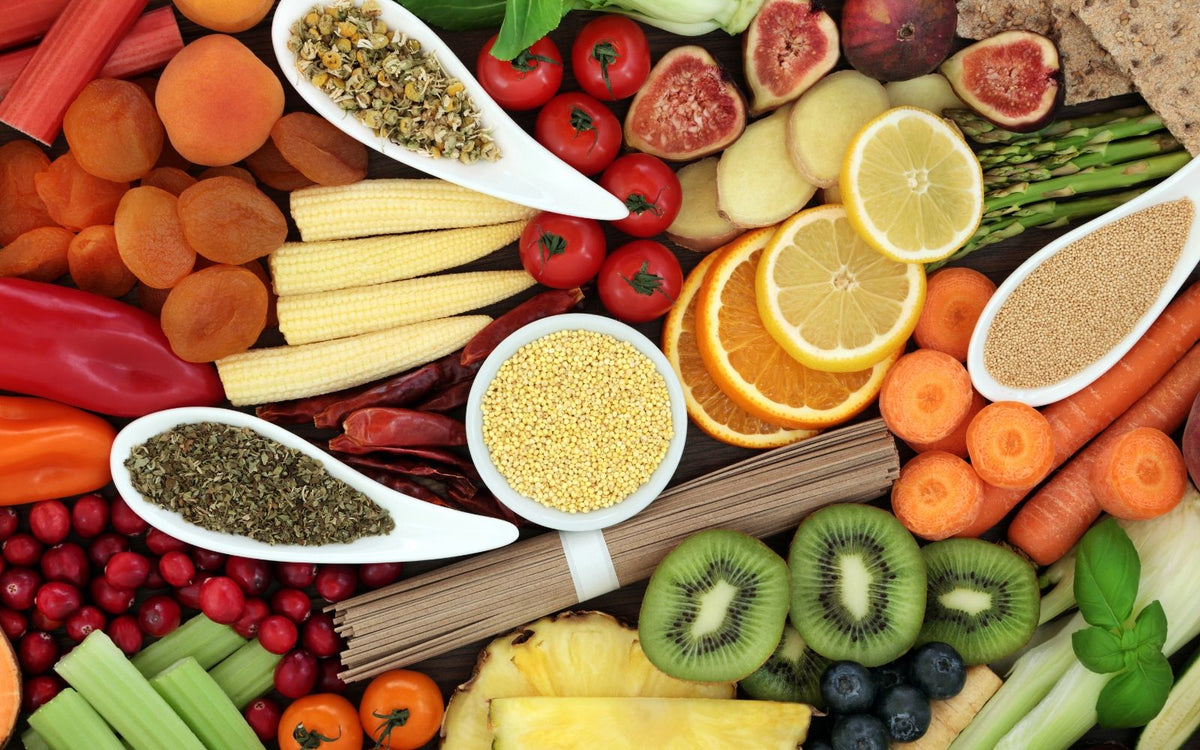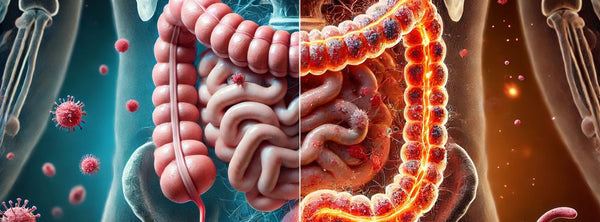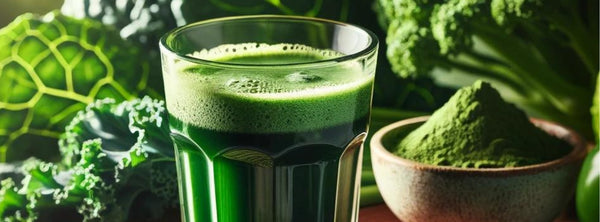
What Are Prebiotic Fibres?
Prebiotics are particular types of fibres that pass through the digestive tract undigested, only to be devoured by various beneficial and commensal organisms within the intestines. The by-products of this gourmet feast are substances called, Short Chained Fatty Acids, with the main ones being Butyrate, Acetate and Propanoate.
Health Benefits of Prebiotic Fibres and Short Chained Fatty Acids include;
- The only food source that feeds and nourishes the billions of beneficial gut bacteria that make up our microbiome and gut-based immune system.
- Increases levels of beneficial bacteria
- Provide nourishment to the intestinal cells and prevent abnormal cell growth.
- Maintain glucose balance
- Assist lipid metabolism and appetite regulation
- Acetate can also cross the blood-brain barrier and plays a vital role in brain health.
- Improves heart health by reducing cholesterol
- Skin conditions including dermatitis
- Stronger Bones
- More significant cognitive function and brain health
- Improved memory, learning and attention
- Moods disorders and anxiety
- Autism spectrum disorder
- Greater immune strength and health
Types Of Prebiotic Fibres And Health Benefits
Not all fibres are Prebiotic Fibres. To be classified as a Prebiotic Fibre, it has to be digestible by the beneficial bacteria within the gut. There are several different types of Prebiotic Fibres found in our foods which have multiple health benefits. The majority of Prebiotic Fibres fall into one of the Prebiotic types below;
Inulin - is found in Jerusalem artichoke, garlic, asparagus, onions and chicory. Health benefits of inulin include; increasing levels of Butyrate, improving the health and numbers of the intestinal micro-organisms and a reduction inflammation and improvement in the gut barrier function. Butyrate is the primary fuel source for intestinal cells, in particular, the colonocytes and enterocytes. Also, inulin assists in relieving constipation, helping to control diabetes, improving bone mineral absorption, supporting heart health and lowering cholesterol, assisting in the prevention of abnormal intestinal cells, polyps and colon cancer, promoting weight loss and reducing insulin resistance.
Oligosaccharides - are found in blue agave, bananas, nopal cactus, onions, yacon root, chicory root, asparagus, garlic and leeks. It is sweet-tasting and used as an alternative to sugar. Health benefits include; lowering cholesterol and reducing blood sugar fluctuations. Oligosaccharides found in Nopal Cactus have shown to increase levels of the beneficial bacteria species, lactobacillus and bifidobacteria, by up to 25%.
Arabinogalactans - is found in carrots, leeks, radish, larch tree, turmeric, echinacea, corn, wheat, pear and tomatoes. Health benefits of Arabinogalactans include; immune enhancement, increasing resistance to infections including the common cold and increased levels of Butyrate, Acetate and Propanoate, in particular the latter two.
Galactooligosaccharide - are found in lentils, kidney beans, lima beans, chickpeas and green peas. Health benefits include; improving levels of the beneficial bifidobacteria and lactobacilli bacteria, enhancing gut immune response and relieving constipation by improving stool frequency.
Resistant Starch - is found in high amounts in green bananas, lentils, white beans, oats, barley, cold potatoes and rice. Health benefits of Resistance Starch include; increased levels of Short Chain Fatty Acids - Butyrate, Acetate, Propanoate and Valerate, improved the health and numbers of beneficial gut bacteria, strengthening the microbiome, protection against colon cancer, improved weight management and a reduction of blood sugar fluctuations.
Did You Know?
Beneficial gut bacteria produce a wide range of vitamins which the body utilises including; B1, B2, B3, B5, B6, B12, folate, biotin, choline and vitamin K2. These amazing bacteria are like permanent multivitamins inside your gut and live on Prebiotic Fibres.
Side Effects Of Prebiotic Fibres
Prebiotics are safe to take and have numerous health benefits. Still, for some people, there can be side effects. For people whose diet is low in fibre rich foods, suddenly increasing prebiotic fibres may cause flatulence, bloating and abdominal pain. These uncomfortable digestive symptoms are mainly due to the ecology of the gut and an imbalance between good and harmful organisms. Generally, you will find, with the onset of these types of symptoms, there are more of the bad guys present than the beneficial ones. To avoid these unpleasant side effects, just start with a small amount of the fibre and slowly build it up over a few weeks. This way, the intestines and beneficial bacteria can adjust slowly to the increased fibre levels.
However, If after a few weeks of slowly increasing fibre levels, you still have flatulence and bloating present, it may indicate a condition called Dysbiosis. This occurs when there are too many harmful organisms in the gut and not enough beneficial ones. To overcome Dysbiosis, we recommend the Beneficial Bacteria Health Pack. This pack contains antimicrobial herbs, probiotics and Prebiotics to eliminate harmful organisms and repopulate the beneficial ones.
Additionally, for some people, foods that contain prebiotic fibres can cause digestive upsets similar to that of Irritable Bowel Syndrome. If these symptoms improve on a FODMAP diet, (which eliminates a lot of the prebiotic-rich foods), then it generally indicates a person is suffering from Small Intestinal Bacterial Overgrowth (SIBO). This condition needs the specialised treatment of a healthcare professional with experience to eradicate SIBO.
Should you need assistance in treating SIBO, Dysbiosis or any other health issue we are here to help, simply take the first step and book an appointment.
How To Increase Prebiotic Fibre Levels
One of the most important things to do is incorporate a wide range of fruits, vegetables, legumes, pulses, beans, nut, seeds and whole grains. More plant-based foods allow for higher nutritional diversity and a more extensive range of Prebiotic fibres.
If the daily diet is lacking in Prebiotic Fibres, we recommend ReVitalise. A potent blend of inulin, arabinogalactans, resistant starch and oligosaccharides from Nopal cactus. ReVitalise helps to jump-start Short-Chain Fatty Acid production, as well as digestive, immune and cognitive health.
Hopefully, this article 'What Are Prebiotics and How Do They Improve Health' has given you a greater insight into Prebiotics and how they promote long-term health. Please share on social media and leave a comment, we'd love to hear from you.
Thanks and have a great day!
The information provided in this blog 'What Are Prebiotics and How Do They Improve Health' is general and intended for educational purposes only. We make no claims to diagnose, treat, prevent, alleviate or cure illnesses or diseases with any information or product stated. With any health issue, we suggest you consult your healthcare professional before undertaking any health treatment.
References:
- Holscher HD. Dietary fiber and prebiotics and the gastrointestinal microbiota. Gut Microbes. 2017;8(2):172-184. doi:10.1080/19490976.2017.1290756
- Collins S, Reid G. Distant Site Effects of Ingested Prebiotics. Nutrients. 2016;8(9):523. Published 2016 Aug 26. doi:10.3390/nu8090523
- Collado Yurrita L, San Mauro Martín I, Ciudad-Cabañas MJ, Calle-Purón ME, Hernández Cabria M. Effectiveness of inulin intake on indicators of chronic constipation; a meta-analysis of controlled randomized clinical trials. Nutr Hosp. 2014 Aug 1;30(2):244-52. doi: 10.3305/nh.2014.30.2.7565. PMID: 25208775.
- Dehghan P, Pourghassem Gargari B, Asgharijafarabadi M. Effects of high performance inulin supplementation on glycemic status and lipid profile in women with type 2 diabetes: a randomized, placebo-controlled clinical trial. Health Promot Perspect. 2013 Jun 30;3(1):55-63. doi: 10.5681/hpp.2013.007. PMID: 24688953; PMCID: PMC3963683.
- Griffin IJ, Davila PM, Abrams SA. Non-digestible oligosaccharides and calcium absorption in girls with adequate calcium intakes. Br J Nutr. 2002 May;87 Suppl 2:S187-91. doi: 10.1079/BJNBJN/2002536. PMID: 12088517.
- Boutron-Ruault MC, Marteau P, Lavergne-Slove A, Myara A, Gerhardt MF, Franchisseur C, Bornet F; Eripolyp Study Group. Effects of a 3-mo consumption of short-chain fructo-oligosaccharides on parameters of colorectal carcinogenesis in patients with or without small or large colorectal adenomas. Nutr Cancer. 2005;53(2):160-8. doi: 10.1207/s15327914nc5302_5. PMID: 16573377.
- Arora T, Loo RL, Anastasovska J, Gibson GR, Tuohy KM, Sharma RK, Swann JR, Deaville ER, Sleeth ML, Thomas EL, Holmes E, Bell JD, Frost G. Differential effects of two fermentable carbohydrates on central appetite regulation and body composition. PLoS One. 2012;7(8):e43263. doi: 10.1371/journal.pone.0043263. Epub 2012 Aug 29. PMID: 22952656; PMCID: PMC3430697.
- Canani RB, Costanzo MD, Leone L, Pedata M, Meli R, Calignano A. Potential beneficial effects of butyrate in intestinal and extraintestinal diseases. World J Gastroenterol. 2011;17(12):1519-1528. doi:10.3748/wjg.v17.i12.1519
- Guevara-Arauza, J.C., de Jesús Ornelas-Paz, J., Pimentel-González, D.J. et al. Prebiotic effect of mucilage and pectic-derived oligosaccharides from nopal (Opuntia ficus-indica). Food Sci Biotechnol 21, 997–1003 (2012). doi.10.1007/s10068-012-0130-1
- Odonmazig P, Ebringerová A, Machová E, Alföldi J. Structural and molecular properties of the arabinogalactan isolated from Mongolian larchwood (Larix dahurica L.). Carbohydr Res. 1994 Jan 15;252:317-24. doi: 10.1016/0008-6215(94)90028-0. PMID: 8137369.
- Dion C, Chappuis E, Ripoll C. Does larch arabinogalactan enhance immune function? A review of mechanistic and clinical trials. Nutr Metab (Lond). 2016;13:28. Published 2016 Apr 12. doi:10.1186/s12986-016-0086-x
- Prescilla V Jeurink, Betty CAM van Esch, Anneke Rijnierse, Johan Garssen, Léon MJ Knippels, Mechanisms underlying immune effects of dietary oligosaccharides, The American Journal of Clinical Nutrition, Volume 98, Issue 2, August 2013, Pages 572S–577S, doi.10.3945/ajcn.112.038596
- Gibson, G., McCartney, A., & Rastall, R. (2005). Prebiotics and resistance to gastrointestinal infections. British Journal of Nutrition, 93(S1), S31-S34. doi:10.1079/BJN20041343
- Scholtens PA, Goossens DA, Staiano A. Stool characteristics of infants receiving short-chain galacto-oligosaccharides and long-chain fructo-oligosaccharides: a review. World J Gastroenterol. 2014;20(37):13446-13452. doi:10.3748/wjg.v20.i37.13446
- Birt DF, Boylston T, Hendrich S, et al. Resistant starch: promise for improving human health. Adv Nutr. 2013;4(6):587-601. Published 2013 Nov 6. doi:10.3945/an.113.004325
- Gorbach SL. Microbiology of the Gastrointestinal Tract. In: Baron S, editor. Medical Microbiology. 4th edition. Galveston (TX): University of Texas Medical Branch at Galveston; 1996. Chapter 95. Available from: https://www.ncbi.nlm.nih.gov/books/NBK7670/
- Morowitz MJ, Carlisle EM, Alverdy JC. Contributions of intestinal bacteria to nutrition and metabolism in the critically ill. Surg Clin North Am. 2011;91(4):771-viii. doi:10.1016/j.suc.2011.05.001
- Qing Gu and Ping Li. Biosynthesis of Vitamins by Probiotic Bacteria Submitted: October 27th 2015Reviewed: March 16th 2016Published: July 13th 2016. DOI: 10.5772/63117




